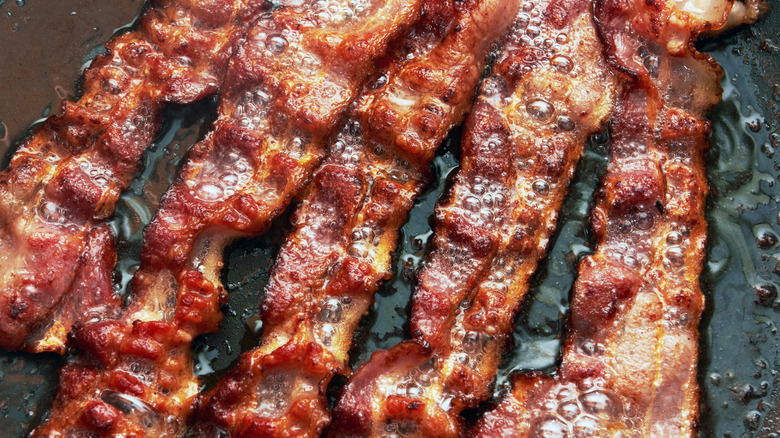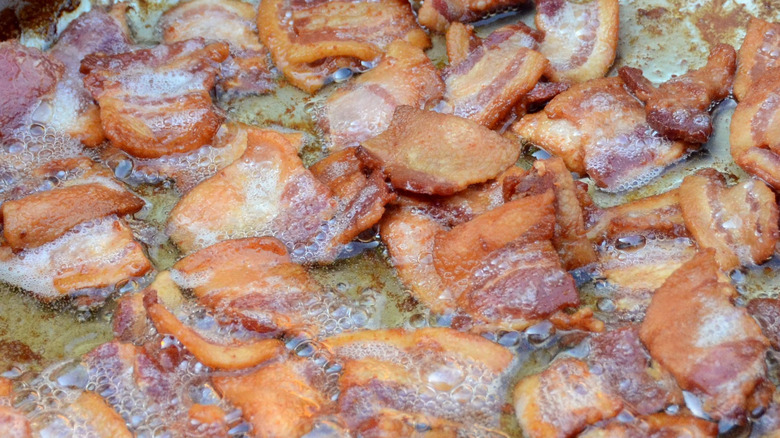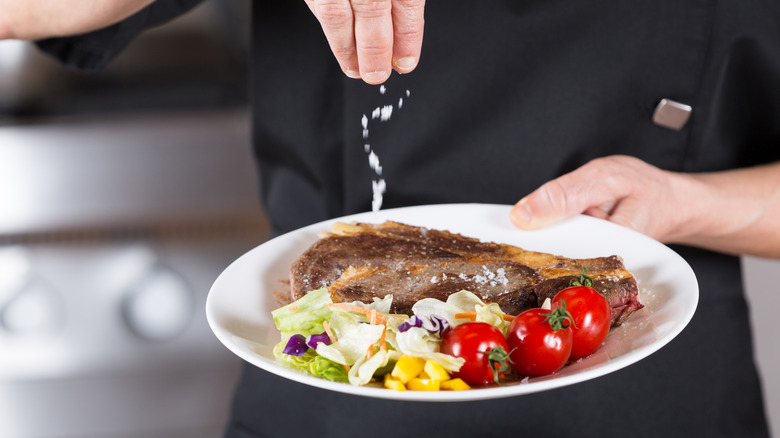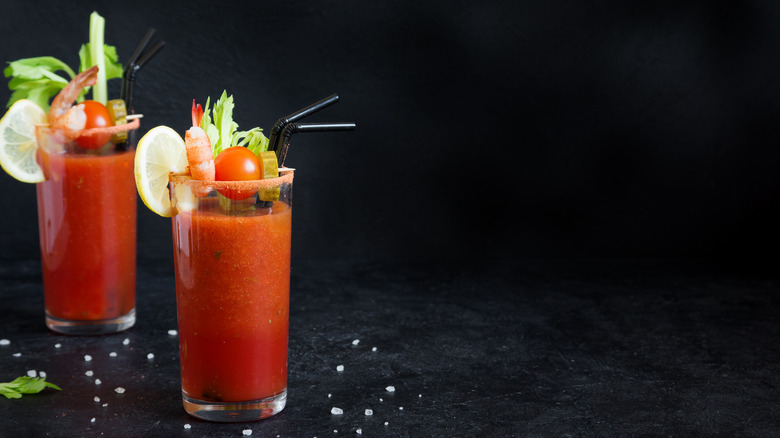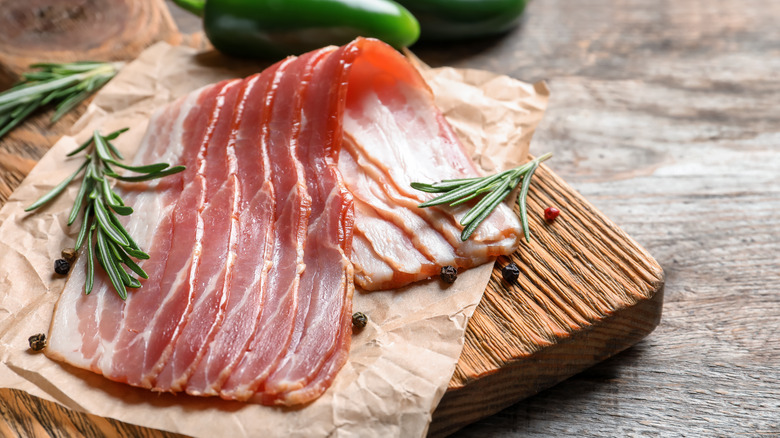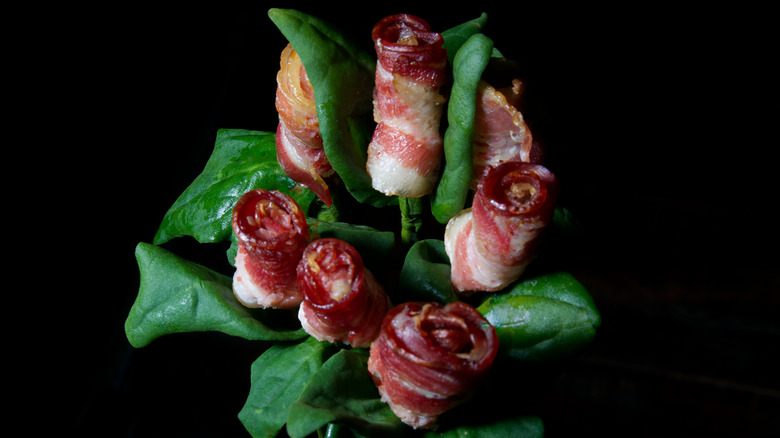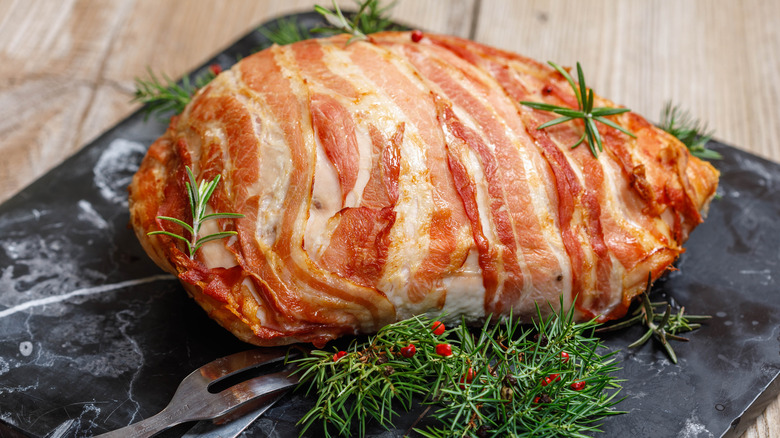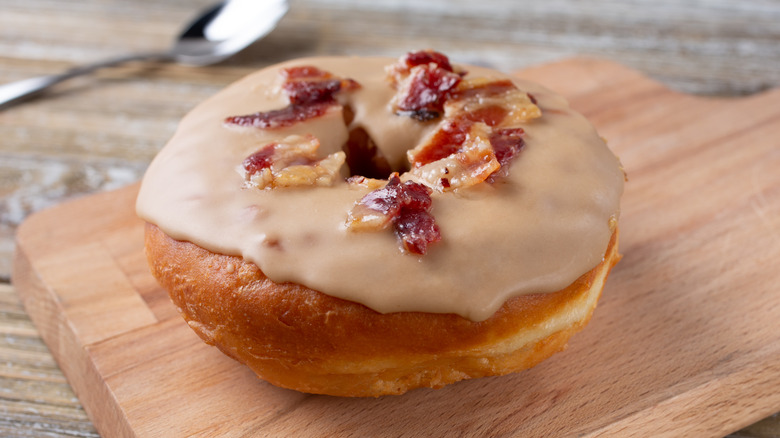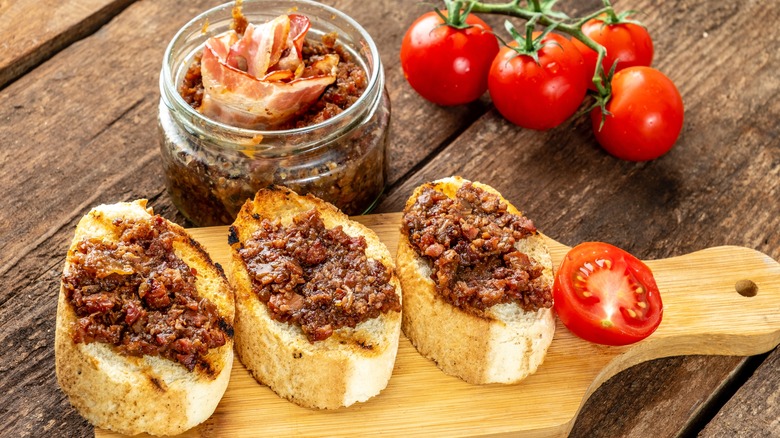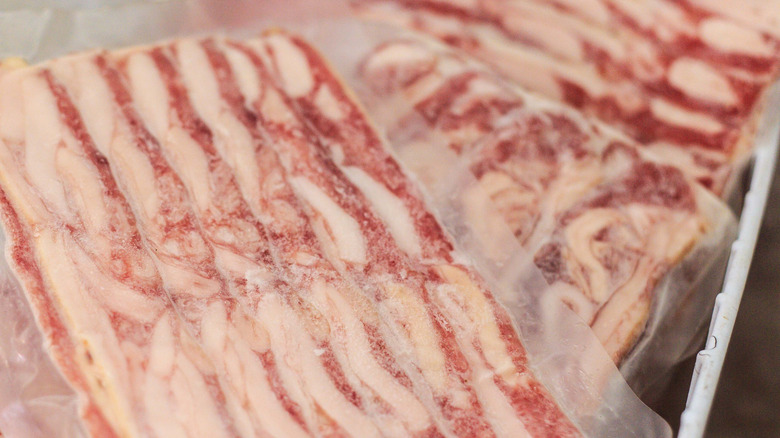11 Things You Didn't Know You Should Be Doing With Bacon
Few foods have the kind of cult following that bacon does. Let's be honest, it's practically the perfect food. With its crunchy texture, umami flavor profile, and that irresistible scent, we find it to be an endlessly utilitarian food item. According to HuffPost, Americans typically eat 18 pounds of bacon annually per capita. That's a lot of porcine deliciousness and calories — 44,000 to be precise. That much bacon consumption also comes with some downsides — namely a lot of sodium, saturated fat, and nitrites, which are a known carcinogen. Still, eaten in moderation, bacon can be a part of a healthy diet.
If themed gifts are any indication as to the popularity of something, there is no shortage of bacon fandom, per Esquire. From ornaments to bandages to pillows to iPhone cases — bacon swag can be found almost everywhere. There is even a "Bacon of the Month” subscription, not unlike the fruit of the month offerings from the likes of Harry and David.
Truthfully, not many topics stir up controversy as fierce as the best way to cook bacon. Everyone has an opinion, although there are some basics that are non-negotiable, notes Tasting Table. However you make it, eat it, or celebrate it, there are some things you really should be doing with bacon and we are here to share them with you. Short of bathing in it — which we aren't sure isn't the greatest idea ever — the possibilities for bacon are virtually endless.
1. Boil your bacon
How does one go viral on TikTok? Bacon of course. Chef Roice Bethel's video on how to perfectly cook bacon in a pan by boiling it has been viewed millions of times and has garnered thousands of comments debating the validity of, and merit of, boiling bacon, per the New York Post. Some think it's genius while others swear by their own tried and true methods ranging from baking to microwaving to grilling it.
Don't trust social media to teach you how to cook bacon? Try an authority like America's Test Kitchen, which also lauds the benefits of boiling bacon. The key is the way in which bacon cooks. Because the fat takes longer to render than the meat does to crisp up, bacon is easily burnt. The addition of water to the pan allows the meat to stay moist while the fat slowly and evenly cooks off, leaving a perfectly executed piece of bacon. As a bonus, by adding water, there is less splatter to make your stovetop a huge, greasy mess.
There are a few keys to boiling bacon properly. First, start off in a cold pan. Only use a couple of tablespoons of water and cook over medium heat so it doesn't evaporate too rapidly. Make sure to flip your bacon regularly so it cooks evenly on both sides. Lastly, properly drain your bacon once it is cooked to remove any residual fat.
2. Make a bacon candle
We've always thought that if someone could come up with a line of food-scented candles they'd become millionaires. Imagine a house redolent with roasted garlic, sauteed onions, and bacon. Well, you don't have to imagine anymore because apparently great minds think alike. According to Boston.com, the Yankee Candle Co. developed a line of candles in 2013 to launch in time for Father's Day called "Man Candles," which featured a bacon-scented option called "MMM, Bacon." The scent isn't listed in their current offerings on their website so we wondered if there was a recipe for making homemade bacon candles. Sure enough, we found one.
Thrillist has a recipe that is so simple it's almost comical. After discovering how easy it is to make, we may never buy another gift for a bacon-loving human again. All it takes is a mason jar, a wick, some super glue, and copious quantities of bacon. Once the bacon fat is rendered down, it is poured into the mason jar, which has had the wick super-glued into it. As the fat cools, it hardens into a candle. When lit, the aroma of cooked bacon will permeate every inch of your home. Bonus: The process of making this candle yields a lot of bacon to nibble on for a midnight snack. We recommend saving it for a BLT sandwich or maybe a Cobb salad.
3. Save your bacon grease
The idea of using bacon grease to cook with may sound like something categorically unhealthy and perhaps undesirable. However, bacon grease has long been utilized for cooking around the world, particularly in the Deep South, per MasterClass. Known as "liquid gold," bacon grease is obtained from the fat that has been rendered out of bacon during the cooking process. Contrary to popular belief, bacon grease does not contain trans fats the way margarine does, and it is higher in monounsaturated fats — the good kinds of fat — than butter.
Health considerations aside, the biggest reason to use bacon grease in cooking is its rich, smoky flavor. Unlike lard — which is neutral in flavor and mostly used as a way of improving the texture of baked goods — bacon grease can be used in all manners of cooking from sautéeing to pan-searing. And incorporating it into your culinary delicacies will protect your plumbing, which can easily clog when bacon grease is poured down the drain.
To properly store bacon grease, MasterClass suggests that it is best to strain it through a fine mesh sieve while it is still hot into a container that can be tightly sealed. Once the grease has completely cooled, cover and place the container in the refrigerator. It will keep for up to three months in the refrigerator or practically in perpetuity in the freezer.
4. Make bacon salt
According to celebrity chef Mark Bitterman, salt has been a staple of culinary creations worldwide for over 12,000 years (via Cooking Light). While most people are only familiar with the basics — namely table salt and kosher salt — flavored salts of all varieties have become more common. These salts are typically thought of as "finishing salts," meaning they are added at the end of the cooking process prior to serving to enhance the flavor of your dish. One such flavored salt is bacon salt.
Bacon salt is incredibly easy to make and is the perfect homemade gift to give your foodie loved ones. While it does make for a great finishing salt, it is also a great way to amp up the flavor of everything from roasted vegetables to chocolate chip cookies, per BENSA Bacon Lovers Society.
The recipe is as simple as baking the bacon in the oven until crispy, draining it, then cooling it. Once cooled, the bacon can be processed in a food processor until pulverized into tiny pieces. The final step — add the kosher salt and pulse together to combine. If you want to jazz up the flavor a bit, you can brush the uncooked bacon with liquid smoke and sprinkle it with freshly cracked pepper or another spice. Store the finished product in an air-tight container in the refrigerator where it will keep for up to four weeks, or in the freezer, where it will last six months.
5. Make bacon-infused vodka
According to Cocktails Wiki, meat-infused alcoholic beverages are nothing new. There is evidence dating as far back as the 17th century of savory cocktails, and Ernest Hemingway himself enjoyed something called a "Bull Shot" at Harry's bar in Venice during the 1940s. The marriage made in heaven has to do with the way the meat accentuates the smokiness of hard liquors, like whiskey. In the early 2000s, bacon began experiencing something of a renaissance, and commercially produced bacon-infused vodka made its way into grocery stores everywhere.
While the meaty spirit is best enjoyed in a martini or a Bloody Mary, its utility is only limited by the creativity of the mixologist in charge. And making your very own bacon-infused vodka is incredibly simple to do. Betty Crocker offers a basic recipe requiring only two ingredients — bacon and vodka. The primary ratio of bacon grease to vodka is one tablespoon per 375-milliliter bottle of vodka. Once the bacon grease is added to the vodka and transferred to mason jars, it is frozen to allow the bacon fat to congeal. After this occurs, it can be strained off and voila — your bacon vodka is ready to be consumed. The recipe itself doesn't mention what kind of vodka to use, however, we don't recommend using a super-expensive one for this recipe.
6. Use different cuts for different recipes
The number of variations of bacon products available commercially is staggering. Knowing which cut to use for a recipe is something invaluable in terms of maximizing the flavor of any culinary creation. But deciphering the distinctions between all the unique options is a daunting task. On The Gas notes that at its most basic, differences can be boiled down to cut, fat content, and how the pork is cured. European bacon typically comes in round slices and is meatier. It also is sourced from the back of the pig — known as the loin — and is not smoked. This differs from American bacon, which tends to be fattier, comes in slices, and is sourced from the pork belly.
For the purposes of determining what kind of bacon to implement in a recipe, Lacademie has created a simple reference guide indicating the cut, source, signature characteristics, and best use for 21 distinct types of bacon. For example, jowl bacon — which comes from the pig's cheek — is great on sandwiches, while lardon — which derives from the pork belly — is most typically associated with French delicacies like Coq au Vin and Beouf Bourgignon. The list also delves into some international options, like Hungarian Szalonna, Chinese Lap Yuk, and Italian Pancetta — each of which possesses unique attributes rendering them suitable for use with spices and ingredients indigenous to those countries.
7. Make bacon roses for your sweetheart
Some bacon-inspired gifts are a little more labor-intensive than others. Bacon roses are one of these items. For the bacon lover in your life — or someone who is allergic to real flowers — consider investing the time to make them a bouquet of bacon roses. They will love it and the bonus is that you can enjoy the fruits — or rather meats — of your labor together.
To make these beautifully delicious bacon roses, simply roll up each bacon slice tightly and insert two toothpicks into an "X" to hold it in place. This will also help the bacon stay upright when cooking. Place a pan in the oven to catch the grease and cook the bacon buds on a wire rack with the toothpick side down. When the bacon is nice and crispy, it's time to turn them into long-stemmed roses. The stems can be created by using fake flowers or even with skewers and spinach leaves. The final product can be presented in a decorative jar filled with rice or another item to stabilize the bouquet.
8. Use bacon to baste a turkey
If you Google methods of keeping a turkey moist during roasting, dozens of suggestions will pop up ranging from brining the bird to stuffing it with fruit to rubbing the breasts with herbed butter. While all of these may have merit for different reasons, wrapping your turkey in bacon is one of our favorite ways of keeping the breast moist while the turkey cooks through completely.
The Pioneer Woman herself, Ree Drummond, agrees. Not only will the fat from the bacon baste the turkey keeping it juicy, but the smoky and salty goodness of the bacon will also impart a delectable flavor into the bird. The final presentation looks incredible as well, with a lattice blanket of bacon dressing the turkey up to the nines.
Drummond mentions two key factors to using bacon on your turkey. First, don't cover the bird tightly or the bacon won't get crispy — and who likes floppy bacon? She suggests instead loosely tenting it with foil and then removing the tent toward the end of the roasting process to crisp up the bacon. Drummond also recommends adding some water to the roasting pan to produce a steam bath that will work like a turkey sauna making its flesh moist and dewy. The final product doesn't just yield the perfect turkey, it comes with the bonus of a bunch of bacon to nosh on.
9. Use it in dessert
The addition of savory ingredients to dessert isn't particularly revolutionary or new. In fact, it's the basis of many of our most treasured treats including kettle corn and Snickers. But the origin of bacon working its way into dessert is attributed to chef Heston Blumenthal and his Fat Duck restaurant, where in 2004 he introduced a bacon-and-egg ice cream that instigated a culinary revolution, per NPR. Soon, chefs around the world began putting bacon in their desserts, including two contestants on the 2006 season of "Top Chef."
If you plan to add bacon to one of your very own sweet recipes, there are a few tips to keep in mind. First, make sure you are using the real deal, not some pseudo-bacon knockoff like turkey bacon. Second, make sure the bacon is completely cooked through and crunchy. This includes properly draining the bacon after cooking. And finally, try using applewood or hickory-smoked bacon for an extra boost of flavor, particularly in dishes that are on the super sweet side. For a sampling of delectable bacon-infused treats, check out this recipe compilation from Mashed.
10. Make bacon jam
Bacon jam is one of the most versatile condiments you can have on hand. While you can purchase it, it is actually quite simple to make your own at home. It just takes a little time, patience, and a bit of willpower, as the finished product is tempting to just dive into before it ever makes it into a mason jar. And talk about a great gift idea for the bacon lover in your life!
While you can use bacon jam in obvious applications — like as a sweet and savory spread on a charcuterie platter or to doctor up your eggs at breakfast — it shines most in more unusual places. We love the idea of incorporating it into your pancakes, waffles, or other sweet recipes. And what better way to make a grilled cheese sandwich even more delectable than by smearing some bacon jam on the bread to compliment a smoked cheese? You can even take it a step further by putting it on a classic peanut butter and jelly sandwich and adding it to S'Mores. Chocolate, marshmallows, and bacon...oh my!
11. Freeze your bacon
Whether bacon was on sale at the grocery store and you decided to stock up or you simply haven't gotten around to cooking what you already have, freezing bacon is a great way of extending the shelf life. According to Mashed, uncooked bacon should only be stored in the refrigerator for a week. After that, it can become rancid and even a health hazard quickly.
There are two ways to freeze bacon. Uncooked bacon can simply be wrapped in foil and placed in a Ziploc baggie. It will keep for up to three months — although for maximum quality one month is recommended. Cooked bacon should be placed on a baking sheet lined with wax paper and then placed in the freezer. Once the individual slices of cooked bacon are frozen, they can be placed in a Ziploc bag and thrown back into the freezer where they will last for one month.
Tasting Table offers an additional method for freezing uncooked bacon that allows you to use only one or two slices at a time rather than thawing the entire package. Similarly to cooked bacon, the uncooked bacon can be placed onto a baking sheet lined with parchment paper and then transferred to the freezer. Once the individual slices are frozen you can put them into a Ziploc baggie and freeze them. Again, make sure you use the bacon within a month for optimum flavor and texture and no longer than three months after freezing for safety.
